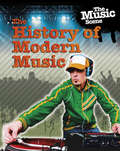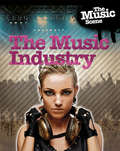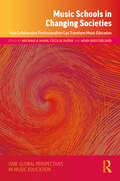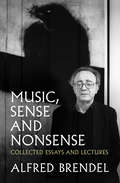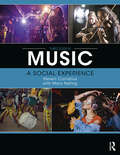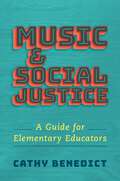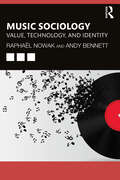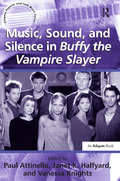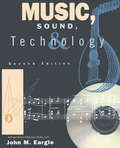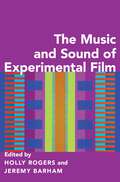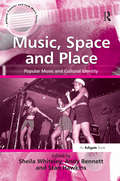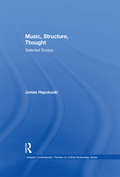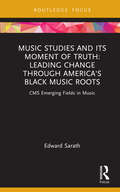- Table View
- List View
The Music Scene: The History of Modern Music (The\music Scene Ser.)
by Matt AnnissThe Music Scene offers a detailed yet readable look at the world of contemporary music for young people. Full of practical, how-to advice and fascinating case studies on many of the world's favourite bands and artists, The Music Scene examines live gigs, recording and contracts, publicity, merchandising and changing fashions in contemporary music. Written by a music journalist, The Music Scene is certain to strike a chord with any aspiring young pop musician.
The Music Scene: The Music Industry (The\music Scene Ser.)
by Matt AnnissThe Music Scene offers a detailed yet readable look at the world of contemporary music for young people. Full of practical, how-to advice and fascinating case studies on many of the world's favourite bands and artists, The Music Scene examines live gigs, recording and contracts, publicity, merchandising and changing fashions in contemporary music. Written by a music journalist, The Music Scene is certain to strike a chord with any aspiring young pop musician.
Music Schools in Changing Societies: How Collaborative Professionalism Can Transform Music Education (ISME Series in Music Education)
by Michaela Hahn, Cecilia Björk, and Heidi WesterlundMusic Schools in Changing Societies addresses the need to understand instrumental and vocal pedagogy beyond the individual sphere of teacher–student interactions and psychological phenomena, focusing instead on the wider sociocultural, spatial, and institutional contexts of music education. Viewing music education through the perspective of collaboration, the book focuses on the context of European music schools, which have developed a central role in publicly funded educational and cultural systems. The authors demonstrate that multilevel collaboration is a vital part of how music educators and the schools where they work can respond to wider societal concerns in ways that improve educational quality. Presenting examples of innovative practices and collaborative settings from twelve European countries, this book offers new and inspiring perspectives on how music schools can support the transformation towards collaborative professionalism in instrumental and vocal music education. With contributions from a wide range of researchers and professional educators, the book shows how a collaborative approach to music education can address major policy issues such as inclusion, democracy, and sustainability. Addressing current institutional and curricular challenges, Music Schools in Changing Societies presents a unique outlook on how music schools in contemporary societies can survive and thrive in times of change.
Music Schools in Changing Societies: How Collaborative Professionalism Can Transform Music Education (ISME Series in Music Education)
Music Schools in Changing Societies addresses the need to understand instrumental and vocal pedagogy beyond the individual sphere of teacher–student interactions and psychological phenomena, focusing instead on the wider sociocultural, spatial, and institutional contexts of music education. Viewing music education through the perspective of collaboration, the book focuses on the context of European music schools, which have developed a central role in publicly funded educational and cultural systems. The authors demonstrate that multilevel collaboration is a vital part of how music educators and the schools where they work can respond to wider societal concerns in ways that improve educational quality. Presenting examples of innovative practices and collaborative settings from twelve European countries, this book offers new and inspiring perspectives on how music schools can support the transformation towards collaborative professionalism in instrumental and vocal music education. With contributions from a wide range of researchers and professional educators, the book shows how a collaborative approach to music education can address major policy issues such as inclusion, democracy, and sustainability. Addressing current institutional and curricular challenges, Music Schools in Changing Societies presents a unique outlook on how music schools in contemporary societies can survive and thrive in times of change.
Music, Science, Philosophy: Models in the Universe of Thought
by Jamie C. KasslerThis book stresses the interrelatedness of knowledge by extricating models that cut across traditional disciplinary boundaries. For example, science can find models from the technology and semantic field of music, music can find its models from the technology and semantic field of science, and each domain may be guided by a philosophical or metaphysical principle - thus, the title of the book. But the book itself is structured as a mirror image of its title. Chapters 1-6 provide instances of the role of music in such domains as epistemology and logic, as well as in the early modern sciences of developmental biology, continuum mechanics, anatomy and physiological psychology, whereas Chapters 7-10 provide instances of what some other domains of knowledge have given back to the philosophy and theory of music.
Music, Science, Philosophy: Models in the Universe of Thought (Variorum Collected Studies #No. 713)
by Jamie C. KasslerThis book stresses the interrelatedness of knowledge by extricating models that cut across traditional disciplinary boundaries. For example, science can find models from the technology and semantic field of music, music can find its models from the technology and semantic field of science, and each domain may be guided by a philosophical or metaphysical principle - thus, the title of the book. But the book itself is structured as a mirror image of its title. Chapters 1-6 provide instances of the role of music in such domains as epistemology and logic, as well as in the early modern sciences of developmental biology, continuum mechanics, anatomy and physiological psychology, whereas Chapters 7-10 provide instances of what some other domains of knowledge have given back to the philosophy and theory of music.
Music, Sense and Nonsense: Collected Essays and Lectures
by Alfred BrendelAlfred Brendel, one of the greatest pianists of our time, is renowned for his masterly interpretations of Haydn, Mozart, Beethoven, Schubert and Liszt, and has been credited with rescuing from oblivion the piano music of Schubert's last years. Far from having merely one string to his bow, however, Brendel is also one of the world's most remarkable writers on music - possessed of the rare ability to bring the clarity and originality of expression that characterised his performances to the printed page. The definitive collection of his award-winning writings and essays, Music, Sense and Nonsense combines all of his work originally published in his two classic books, Musical Thoughts and Afterthoughts and Music Sounded Out, along with significant new material on a lifetime of recording, performance habits and reflections on life and art. As well as providing stimulating reading, this new edition provides a unique insight into the exceptional mind of one of the outstanding musicians of the twentieth and twenty-first centuries. Whether discussing Bach or Beethoven, Schubert or Schoenberg, Brendel's reflections are illuminating and challenging, a treasure for the specialist and the music lover alike.
Music, Sexuality and the Enlightenment in Mozart's Figaro, Don Giovanni and Così fan tutte
by Charles FordMusic, Sexuality and the Enlightenment explains how Mozart's music for Le nozze di Figaro, Don Giovanni and Così fan tutte 'sounds' the intentions of Da Ponte's characters and their relationships with one another. Mozart, by way of the infinitely generative and beautiful logic of the sonata principle, did not merely interpret Da Ponte's characterizations but lent them temporal, musical forms. Charles Ford's analytic interpretation of these musical forms concerns processes and structures in detail and at medium- to long-term levels. He addresses the music of a wide range of arias and ensembles, and develops original ways to interpret the two largely overlooked operatic genres of secco recitative and finales. Moreover, Ford presents a new method by which to relate musical details directly to philosophical concepts, and thereby, the music of the operas to the inwardly contradictory thinking of the European Enlightenment. This involves close readings of late eighteenth-century understandings of 'man' and nature, self and other, morality and transgression, and gendered identities and sexuality, with particular reference to contemporary writers, especially Goethe, Kant, Laclos, Rousseau, Sade, Schiller, Sterne and Wollstonecraft. The concluding discussion of the implied futures of the operas argues that their divided sexualities, which are those of the Enlightenment as a whole, have come to form our own unquestioned assumptions about gender differences and sexuality. This, along with the elegant and eloquent precision of Mozart's music, is why Figaro, Giovanni and Così still maintain their vital immediacy for audiences today.
Music, Sexuality and the Enlightenment in Mozart's Figaro, Don Giovanni and Così fan tutte
by Charles FordMusic, Sexuality and the Enlightenment explains how Mozart's music for Le nozze di Figaro, Don Giovanni and Così fan tutte 'sounds' the intentions of Da Ponte's characters and their relationships with one another. Mozart, by way of the infinitely generative and beautiful logic of the sonata principle, did not merely interpret Da Ponte's characterizations but lent them temporal, musical forms. Charles Ford's analytic interpretation of these musical forms concerns processes and structures in detail and at medium- to long-term levels. He addresses the music of a wide range of arias and ensembles, and develops original ways to interpret the two largely overlooked operatic genres of secco recitative and finales. Moreover, Ford presents a new method by which to relate musical details directly to philosophical concepts, and thereby, the music of the operas to the inwardly contradictory thinking of the European Enlightenment. This involves close readings of late eighteenth-century understandings of 'man' and nature, self and other, morality and transgression, and gendered identities and sexuality, with particular reference to contemporary writers, especially Goethe, Kant, Laclos, Rousseau, Sade, Schiller, Sterne and Wollstonecraft. The concluding discussion of the implied futures of the operas argues that their divided sexualities, which are those of the Enlightenment as a whole, have come to form our own unquestioned assumptions about gender differences and sexuality. This, along with the elegant and eloquent precision of Mozart's music, is why Figaro, Giovanni and Così still maintain their vital immediacy for audiences today.
Music: A Social Experience
by Steven Cornelius Mary NatvigBy taking a thematic approach to the study of music appreciation, Music: A Social Experience, Third Edition demonstrates how music reflects and deepens both individual and cultural understandings. Musical examples are presented within universally experienced social frameworks (ethnicity, gender, spirituality, love, and more) to help students understand how music reflects and advances human experience. Students engage with multiple genres (Western art music, popular music, and world music) through lively narratives and innovative activities. A companion website features streaming audio and instructors' resources. The third edition includes: A chapter on Black American music A revised and developed chapter on gender and sexuality A dozen additional Listening Guides, with an emphasis on contemporary popular music Over 100 new full-color images Updated teacher and student resources on the book’s companion website Expanded content throughout, highlighting the social, cultural, and technological changes since publication of the previous edition The culmination of thirty years of experimentation in the music appreciation classroom, this third edition of Music: A Social Experience continues to empower lifelong musical learning by engaging students and readers on their own terms.
MUSIC & SOCIAL JUSTICE C: A Guide for Elementary Educators
by Cathy BenedictIn this book author Cathy Benedict challenges and reframes traditional ways of addressing many of the topics we have come to think of as social justice. Offering practical suggestions for helping both teachers and students think philosophically (and thus critically) about the world around them, each chapter engages with important themes through music making and learning as it presents scenarios, examples of dialogue with students, unit ideas and lesson plans geared toward elementary students (ages 6-14). Taken-for-granted subjects often considered beyond the understanding of elementary students such as friendship, racism, poverty, religion, and class are addressed and interrogated in such a way that honours the voice and critical thinking of the elementary student. Suggestions are given that help both teachers and students to pause, reflect and redirect dialogue with questions that uncover bias, misinformation and misunderstandings that too often stand in the way of coming to know and embracing difference. Guiding questions, which anchor many curricular mandates, are used throughout in order to scaffold critical and reflective thinking beginning in the earliest grades of elementary music education. Where does social justice reside? Whose voice is being heard and whose is being silenced? How do we come to think of and construct poverty? How is it that musics become used the way they are used? What happens to songs initially intended for socially driven purposes when their significance is undermined? These questions and more are explored encouraging music teachers to embrace a path toward socially just engagements at the elementary and middle school levels.
Music Sociology: Value, Technology, and Identity
by Andy Bennett Raphaël NowakMusic Sociology critically evaluates current approaches to the study of music in sociology and presents a broad overview of how music is positioned and represented in existing sociological scholarship. It then goes on to offer a new framework for approaching the sociology of music, taking music itself as a starting point, and considering what music sociology can learn from related disciplines such as critical musicology, ethnomusicology, and cultural studies. As a central form of leisure, consumption, and cultural production, music has attracted significant attention from sociologists who seek to understand its deeper socio-cultural meaning. With case studies that address sound environments, consumption, media technologies, local scenes, music heritage, and ageing, the authors highlight the distinctive nature of musical experience, and show how sociology can illuminate it. Providing both a survey of existing perspectives the sociology of music, and a thought-provoking discussion of how the field can move forward, this concise and accessible book will be a vital reading for anyone teaching or studying music from a sociological standpoint.
Music Sociology: Value, Technology, and Identity
by Andy Bennett Raphaël NowakMusic Sociology critically evaluates current approaches to the study of music in sociology and presents a broad overview of how music is positioned and represented in existing sociological scholarship. It then goes on to offer a new framework for approaching the sociology of music, taking music itself as a starting point, and considering what music sociology can learn from related disciplines such as critical musicology, ethnomusicology, and cultural studies. As a central form of leisure, consumption, and cultural production, music has attracted significant attention from sociologists who seek to understand its deeper socio-cultural meaning. With case studies that address sound environments, consumption, media technologies, local scenes, music heritage, and ageing, the authors highlight the distinctive nature of musical experience, and show how sociology can illuminate it. Providing both a survey of existing perspectives the sociology of music, and a thought-provoking discussion of how the field can move forward, this concise and accessible book will be a vital reading for anyone teaching or studying music from a sociological standpoint.
Music, Sound and Filmmakers: Sonic Style in Cinema
by James WierzbickiMusic, Sound and Filmmakers: Sonic Style in Cinema is a collection of essays that examine the work of filmmakers whose concern is not just for the eye, but also for the ear. The bulk of the text focuses on the work of directors Wes Anderson, Ingmar Bergman, the Coen brothers, Peter Greenaway, Krzysztof Kieślowski, Stanley Kubrick, David Lynch, Quentin Tarantino, Andrey Tarkovsky and Gus Van Sant. Significantly, the anthology includes a discussion of films administratively controlled by such famously sound-conscious producers as David O. Selznick and Val Lewton. Written by the leading film music scholars from Europe, North America, and Australia, Music, Sound and Filmmakers: Sonic Style in Cinema will complement other volumes in Film Music coursework, or stand on its own among a body of research.
Music, Sound and Filmmakers: Sonic Style in Cinema
by James WierzbickiMusic, Sound and Filmmakers: Sonic Style in Cinema is a collection of essays that examine the work of filmmakers whose concern is not just for the eye, but also for the ear. The bulk of the text focuses on the work of directors Wes Anderson, Ingmar Bergman, the Coen brothers, Peter Greenaway, Krzysztof Kieślowski, Stanley Kubrick, David Lynch, Quentin Tarantino, Andrey Tarkovsky and Gus Van Sant. Significantly, the anthology includes a discussion of films administratively controlled by such famously sound-conscious producers as David O. Selznick and Val Lewton. Written by the leading film music scholars from Europe, North America, and Australia, Music, Sound and Filmmakers: Sonic Style in Cinema will complement other volumes in Film Music coursework, or stand on its own among a body of research.
Music, Sound, and Silence in Buffy the Vampire Slayer
by JanetK. HalfyardThe intense and continuing popularity of the long-running television show Buffy the Vampire Slayer (1997-2003) has long been matched by the range and depth of the academic critical response. This volume, the first devoted to the show's imaginative and widely varied use of music, sound, and silence, helps to develop an increasingly important and inadequately covered area of research - the many roles of music in contemporary television. In addressing this significant gap, this book provides an exemplary overview of the functions of music and sound in the interpretation of a television show. This is done through analyses that focus on scoring and source music, the title theme, the music production process, the critically acclaimed musical episode (voted number 13 in Channel Four's One Hundred Greatest Musicals), the symbolic and dramatic use of silence, and the popular reception of the show by its international fan base. In keeping with contemporary trends in the study of popular musics, a variety of critical approaches are taken from musicology, cultural studies, and media and communication studies, specifically employing critique, musical analysis, industry studies, and hermeneutics.
Music, Sound, and Silence in Buffy the Vampire Slayer (Ashgate Popular And Folk Music Ser.)
by JanetK. HalfyardThe intense and continuing popularity of the long-running television show Buffy the Vampire Slayer (1997-2003) has long been matched by the range and depth of the academic critical response. This volume, the first devoted to the show's imaginative and widely varied use of music, sound, and silence, helps to develop an increasingly important and inadequately covered area of research - the many roles of music in contemporary television. In addressing this significant gap, this book provides an exemplary overview of the functions of music and sound in the interpretation of a television show. This is done through analyses that focus on scoring and source music, the title theme, the music production process, the critically acclaimed musical episode (voted number 13 in Channel Four's One Hundred Greatest Musicals), the symbolic and dramatic use of silence, and the popular reception of the show by its international fan base. In keeping with contemporary trends in the study of popular musics, a variety of critical approaches are taken from musicology, cultural studies, and media and communication studies, specifically employing critique, musical analysis, industry studies, and hermeneutics.
Music, Sound, and Technology
by John M. EargleSince its publication in 1990, the first edition of Music, Sound, and Technology has enjoyed wide success and has become a popular text in musical acoustical studies at the university level. In preparing the new edition we have included recent developments in all aspects of music and sound technology, and we have added data on acoustical characteristics of musical in struments. The first edition has been cited for the scope and clarity of its graphics; we have emphasized this to an even greater degree in the second edition. /ME xi Preface to the First Edition This book is about music. the instruments and players who produce it. and the technologies that support it. Although much modern music is produced by electronic means. its underlying basis is still traditional acoustical sound production. and that broad topic provides the basis for this book. There are many fine books available that treat musical acoustics largely from the physical point of view. The approach taken here is to present only the fundamentals of musical phys ics. while giving special emphasis to the relation between instrument and player and stressing the characteristics of instruments that are of special concern to engineers and tech nicians involved in the fields of recording. sound reinforcement. and broadcasting. In order to understand musical instruments in their normal performance environments.
MUSIC & SOUND OF EXPERIMENTAL FILM C
by Holly Rogers and Jeremy BarhamThis book explores music/sound-image relationships in non-mainstream screen repertoire from the earliest examples of experimental audiovisuality to the most recent forms of expanded and digital technology. It challenges presumptions of visual primacy in experimental cinema and rethinks screen music discourse in light of the aesthetics of non-commercial imperatives. Several themes run through the book, connecting with and significantly enlarging upon current critical discourse surrounding realism and audibility in the fiction film, the role of music in mainstream cinema, and the audiovisual strategies of experimental film. The contributors investigate repertoires and artists from Europe and the USA through the critical lenses of synchronicity and animated sound, interrelations of experimentation in image and sound, audiovisual synchresis and dissonance, experimental soundscape traditions, found-footage film, re-mediation of pre-existent music and sound, popular and queer sound cultures, and a diversity of radical technological, aesthetic, tropes in film media traversing the work of early pioneers such as Walther Ruttmann and Len Lye, through the mid-century innovations of Norman McLaren, Stan Brakhage, Lis Rhodes, Kenneth Anger, Andy Warhol, and studio collectives in Poland, to latter-day experimentalists John Smith and Bill Morrison, as well as the contemporary practices of Vjing.
Music, Space and Place: Popular Music and Cultural Identity
by Andy BennettMusic, Space and Place examines the urban and rural spaces in which music is experienced, produced and consumed. The editors of this collection have brought together new and exciting perspectives by international researchers and scholars working in the field of popular music studies. Underpinning all of the contributions is the recognition that musical processes take place within a particular space and place, where these processes are shaped both by specific musical practices and by the pressures and dynamics of political and economic circumstances. Important discourses are explored concerning national culture and identity, as well as how identity is constructed through the exchanges that occur between displaced peoples of the world's many diasporas. Music helps to articulate a shared sense of community among these dispersed people, carving out spaces of freedom which are integral to personal and group consciousness. A specific focal point is the rap and hip hop music that has contributed towards a particular sense of identity as indigenous resistance vernaculars for otherwise socially marginalized minorities in Cuba, France, Italy, New Zealand and South Africa. New research is also presented on the authorial presence in production within the domain of the commercially driven Anglo-American music industry. The issue of authorship and creativity is tackled alongside matters relating to the production of musical texts themselves, and demonstrates the gender politics in pop. Underlying Music, Space and Place, is the question of how the disciplines informing popular music studies - sociology, musicology, cultural studies, media studies and feminism - have developed within a changing intellectual climate. The book therefore covers a wide range of subject matter in relation to space and place, including community and identity, gender, race, 'vernaculars', power, performance and production.
Music, Space and Place: Popular Music and Cultural Identity (Ashgate Popular And Folk Music Ser.)
by Andy BennettMusic, Space and Place examines the urban and rural spaces in which music is experienced, produced and consumed. The editors of this collection have brought together new and exciting perspectives by international researchers and scholars working in the field of popular music studies. Underpinning all of the contributions is the recognition that musical processes take place within a particular space and place, where these processes are shaped both by specific musical practices and by the pressures and dynamics of political and economic circumstances. Important discourses are explored concerning national culture and identity, as well as how identity is constructed through the exchanges that occur between displaced peoples of the world's many diasporas. Music helps to articulate a shared sense of community among these dispersed people, carving out spaces of freedom which are integral to personal and group consciousness. A specific focal point is the rap and hip hop music that has contributed towards a particular sense of identity as indigenous resistance vernaculars for otherwise socially marginalized minorities in Cuba, France, Italy, New Zealand and South Africa. New research is also presented on the authorial presence in production within the domain of the commercially driven Anglo-American music industry. The issue of authorship and creativity is tackled alongside matters relating to the production of musical texts themselves, and demonstrates the gender politics in pop. Underlying Music, Space and Place, is the question of how the disciplines informing popular music studies - sociology, musicology, cultural studies, media studies and feminism - have developed within a changing intellectual climate. The book therefore covers a wide range of subject matter in relation to space and place, including community and identity, gender, race, 'vernaculars', power, performance and production.
Music, Structure, Thought: Selected Essays
by James HepokoskiAmong the most original and provocative musicological writers of his generation, James Hepokoski has elaborated new paradigms of inquiry for both music history and music theory. Advocating fundamental shifts of methodological reorientation within the quest for potential musical meanings, his work spans both disciplines and offers substantial challenges for each. At its core is the conviction that a close study of musical genres, procedures, and structures those qualities of a composition that are specifically musical is essential to any responsible hermeneutic enterprise. Selected from writings from 1984 to 2008, this collection of essays provides a generous introduction to the author‘s most innovative and influential work on a wide variety of topics: musicological methodology, issues of staging and performance, Italian opera, program music, and exemplary studies of individual pieces.
Music, Structure, Thought: Selected Essays
by James HepokoskiAmong the most original and provocative musicological writers of his generation, James Hepokoski has elaborated new paradigms of inquiry for both music history and music theory. Advocating fundamental shifts of methodological reorientation within the quest for potential musical meanings, his work spans both disciplines and offers substantial challenges for each. At its core is the conviction that a close study of musical genres, procedures, and structures those qualities of a composition that are specifically musical is essential to any responsible hermeneutic enterprise. Selected from writings from 1984 to 2008, this collection of essays provides a generous introduction to the author‘s most innovative and influential work on a wide variety of topics: musicological methodology, issues of staging and performance, Italian opera, program music, and exemplary studies of individual pieces.
Music Studies and Its Moment of Truth: CMS Emerging Fields in Music (CMS Emerging Fields in Music)
by Edward SarathMusic Studies and Its Moment of Truth: Leading Change through America’s Black Music Roots presents a new framework for racial justice discourse in the context of music studies and education. Centering on Black American Music, the book issues challenges to both the conventional music studies paradigm and decades-old reform efforts.While Black American Music ranks high among America’s contributions to world culture, and offers musicians powerful tools for musical practice and understanding, this musical legacy remains remarkably marginalized even in activist conversations. The author argues that this reflects lingering and unexamined racist patterns that persist even among the most fervent voices for anti-racist interventions, and addresses the need for a higher-order activist framework within music studies.Delving further into the transformative changes needed to pursue racial justice, the short pieces collected in this book discuss topics including a shift from multicultural ideology to a transcultural model of musical pluralism, analysis of the multi-tiered nature of musical racism, the whitewashing of music studies activism, K-12 music teacher education as the locus for paradigmatic change and the potential for a transformed model of music studies to catalyze an overarching revolution in creativity and consciousness in both education and society at large. Critiquing the failures of progressive reform efforts and conventional reaction, this book argues that major changes are needed to the discourse on racism in music studies, and envisions new paradigms for the future.
